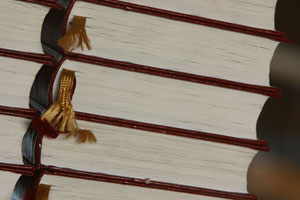
JUSTIN POPE
As the economy walloped their finances, students and families saw little relief this fall from rising college costs, which jumped 6.4 percent at state universities, according to new figures out Wednesday.
Next year is already looking bad, too. More state budget cuts to higher education are virtually certain, and schools in at least two states – Michigan and Rhode Island – will take the unusual step of raising prices midyear.
“At a time of flattening wages, widespread job losses and shrinking home values, the last thing parents need is another big increase in the cost of college,” said James Boyle, president of the group College Parents of America.
But that’s what they got.
For the current academic year, the average list price of tuition and fees at four-year public universities rose $394, or 6.4 percent, to $6,585 for in-state students. At private colleges, prices rose $1,399, or 5.9 percent, to $25,143, according to the annual “Trends in College Pricing” report from the College Board.
It’s important to remember that many students don’t pay the full list price. At private colleges, grants and tax breaks lower the average net price to about $14,900. At public universities the average actual cost is only about $2,900.
And while some private colleges now exceed $50,000 when room and board are figured in, they are the exception. Overall, more than half of four-year college students attend institutions where the list price for tuition and fees is less than $9,000.
“No student should rule out a private college and university without first checking with the institution about financial aid options,” said David Warren, president of the National Association of Colleges and Universities. He noted that over the last decade independent colleges have increased financial aid at more than three times the rate they’ve increased tuition.
But they’ve done so largely by tapping rapidly growing endowments. Now, like family savings, college endowments have taken a beating on Wall Street, just as demand for financial aid rises. Some colleges may try to hold down prices – Benedictine University in Lisle, Ill., has announced a freeze – but in most cases the pressure to charge more will be greater.
“If current economic patterns continue, it is possible that some tuition increases next year will be higher than the usual 5 to 6 percent at our institutions,” Warren said.
At public institutions – which enroll about three-quarters of American college students – the economy already has prompted big increases. At least 21 states cut higher education spending this year, and some passed tuition increases well above the national average, according to the Center on Budget and Policy Priorities. The University of Florida, for instance, is eliminating 430 faculty and staff positions, lowering enrollment by 1,000 students and increasing prices 15 percent for in-state undergraduates.
“Despite every effort by our institutions to increase aid to students and families, I am afraid this year’s report may prove only to be a snapshot of a time in history that we might soon be referring to as the ‘good old days,'” said Molly Corbett Broad, president of the American Council on Education, the principal group representing colleges in Washington, D.C.
The College Board report emphasized that, accounting for overall inflation, prices rose less than 1 percent this year, and actually declined at public two-year colleges. But that’s only because overall inflation was unusually high – about 5.6 percent.
“No one really thinks it’s easier to pay for college just because other prices have gone up,” Sandy Baum, economics professor at Skidmore College and senior policy analyst at the College Board, said in a telephone interview. While families may postpone other big-ticket items, “It’s harder to wait to go to college than to wait to buy a car,” she said.
Public two-year colleges once again were the biggest bargain. Average list prices there rose $108, or 4.7 percent, to $2,402. Factoring in financial aid, the College Board estimates the average net cost is only about $100.
The College Board also reported that the amount of private borrowing – the loans students take out on top of federal aid – declined slightly in 2007-2008. After years of double-digit increases that fueled worries about student debt, private borrowing has plateaued.
Baum attributed the decline to expanded eligibility for government loans. But it also reflects private lenders beginning to tighten credit requirements – especially if parents won’t co-sign the loan.
“To the extent that it’s demand-side, that fewer people want private loans because they can get the money from the federal government, that’s clearly a good thing,” Baum said.
The most recent figures, from 2006-2007, show about 60 percent of bachelor’s degree recipients graduated with debt. The average debt at graduation for those borrowers rose about $400 from the year before to $22,700.









